By SPCO Education Manager Eleanor GrandPre
Now in its 22nd year, The Saint Paul Chamber Orchestra’s CONNECT program serves students in grades 1-5 in twelve Minneapolis and Saint Paul public schools and in three elementary schools around the state of Minnesota and is free of charge to all partnering schools. The program provides supplementary music education resources to students, curriculum and support for teachers, musician visits to each of the participating schools and a live cumulative music education theme-based orchestra concert for each of the students participating in our local program. Our feedback increasingly indicates that teachers are looking for more performances for their students. With the complexities of the school schedules in mind and a heightened desire to deliver more performances to the students, the CONNECT virtual visit program was born. Liquid Music curator and producer Kate Nordstrum and SPCO’s education manager Eleanor GrandPre worked together to find a partnership with a Liquid Music artist who could provide these schools with a unique and transformative performance that could be experienced virtually.
Flutist and composer Nathalie Joachim, this year’s Liquid Music Virtual Artist in Residence, was the perfect answer. With a passion for performance, composing new music and introducing music to young listeners, Nathalie is exactly the type of artist students should be exposed to. Additionally, Nathalie is young, a woman, and a woman of color – all underrepresented demographics in the world of classical music and composition. For the highly diverse student body of the CONNECT program (over 5,000 students), it is especially important, and significant, to see themselves in the artists they interact with.
The nature of the virtual visit posed a unique challenge for students who were used to a live musician visit and our goal was to make this virtual experience just as meaningful as a live experience. Students frequently looked forward to asking their own questions at the end of a musician visit, so we integrated Q&A to the virtual visit. In October 2016, Nathalie produced an introduction video for the CONNECT schools.
This video helped students get to know her as a composer, a flutist and singer. Eleanor GrandPre produced an online student guide to help students navigate through the video and stay engaged. In addition to introducing herself to students via this video, Nathalie shared a performance of her piece “Aware”. After viewing the video from Nathalie, students will have the chance to respond with questions via “selfie” video. These student questions will be sent to Natahlie, and she will select at least one student question from each school to respond to. In the Spring, a second video will be produced that includes the student questions via their “selfie” videos and Nathalie’s direct responses.
This is an exciting partnership; one that will help students understand the versatility of a career in music, the exciting world of contemporary music, and give students the opportunity to connect with a living composer.
Keep up with Fanm d'Ayiti on the Liquid Music Blog:
Introducing Nathalie Joachim
Follow Nathalie Joachim:
Website: nathaliejoachim.com
Facebook: facebook.com/nathalie.joachim.39
Twitter: @flutronix (twitter.com/flutronix)
Instagram: @njoachim (instagram.com/njoachim)
Youtube: youtube.com/c/nathaliejoachim
FOLLOW LIQUID MUSIC FOR UPDATES AND ANNOUNCEMENTS
Twitter: @LiquidMusicSPCO (twitter.com/LiquidMusicSPCO)
Instagram: @LiquidMusicSeries (instagram.com/liquidmusicseries)
Facebook: facebook.com/SPCOLiquidMusic
Podcast: Liquid Music Playlist































































